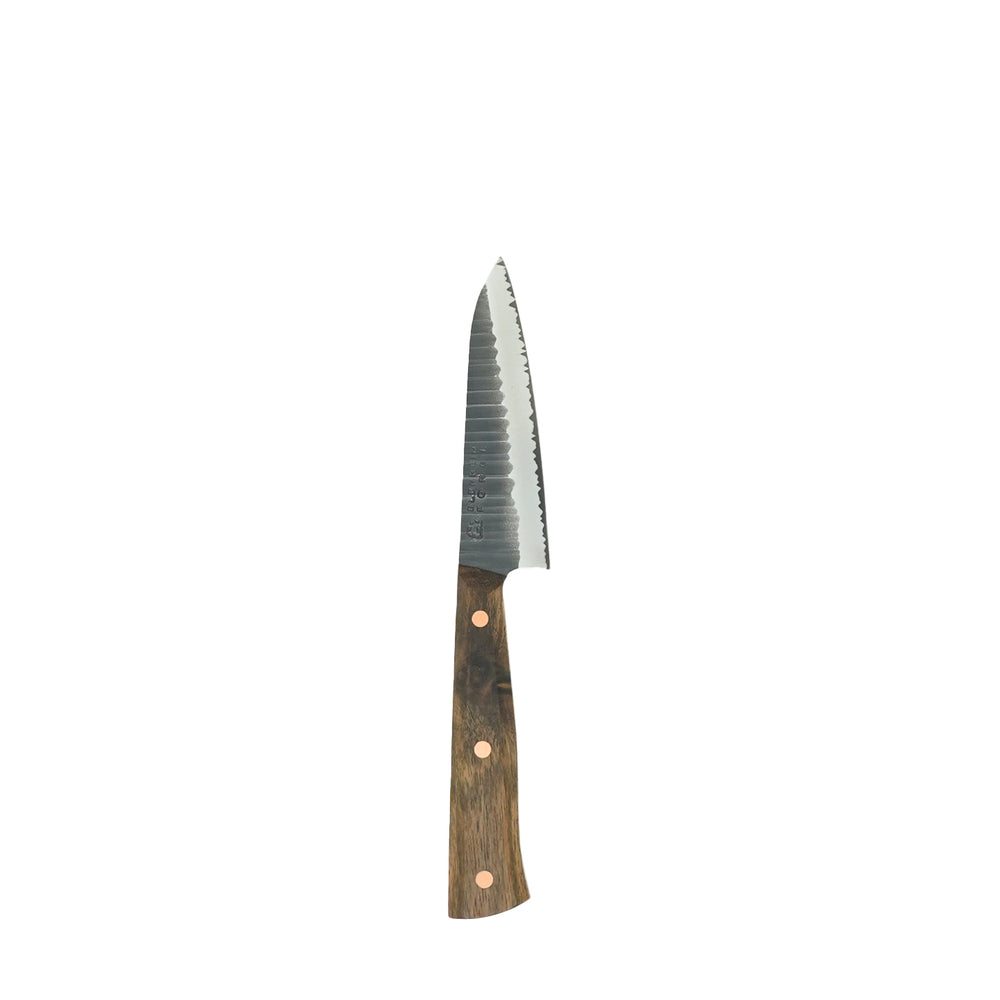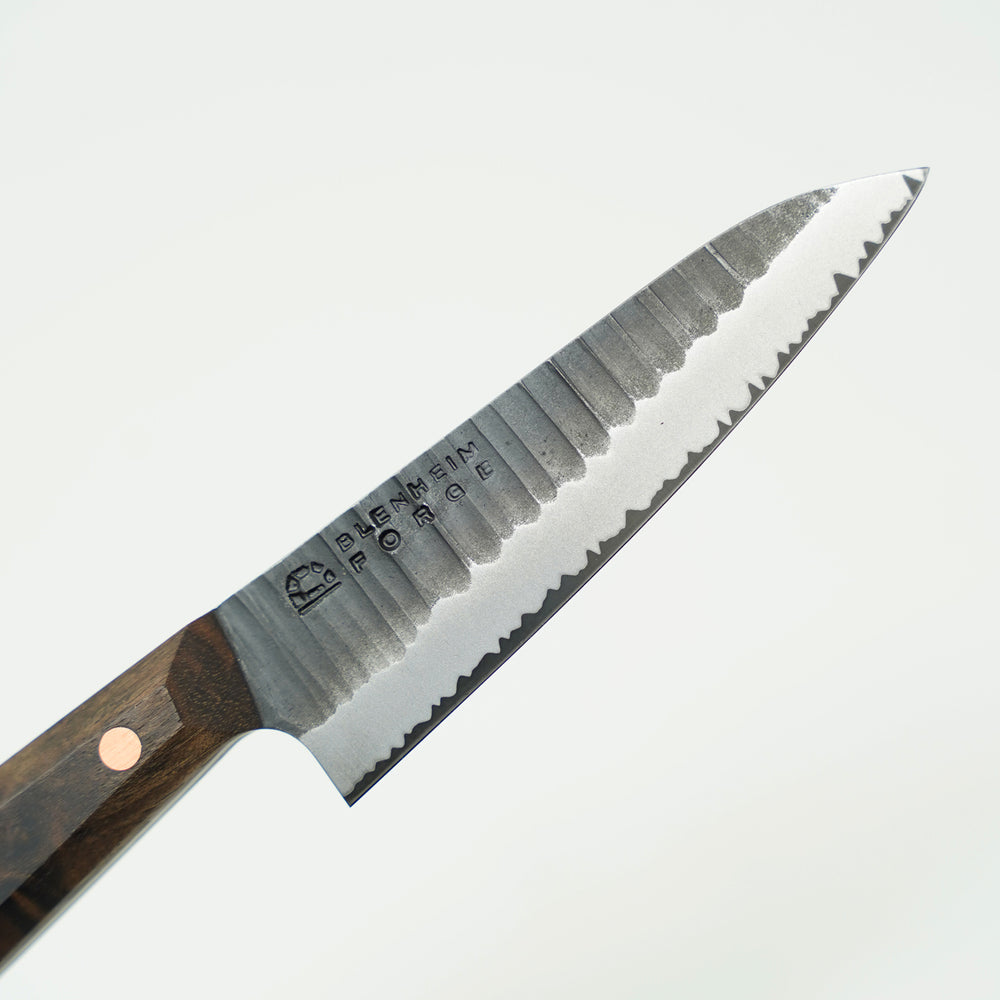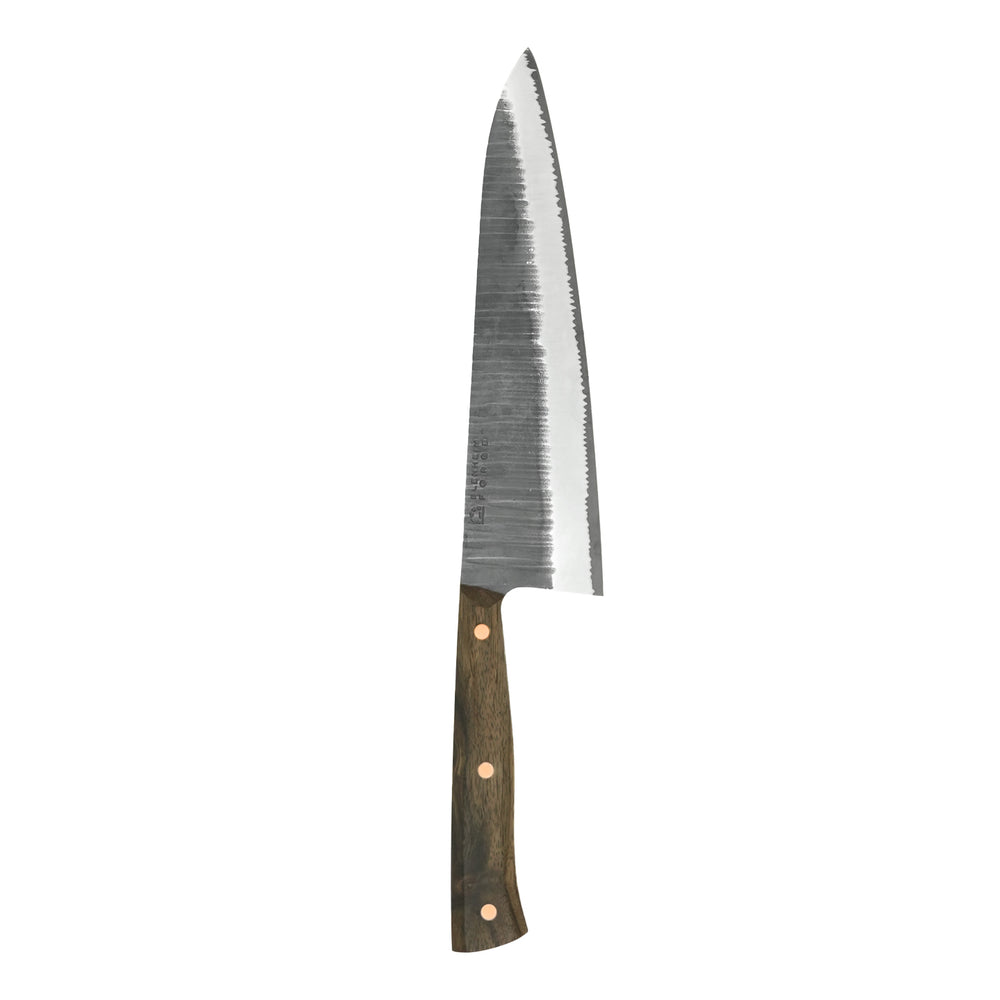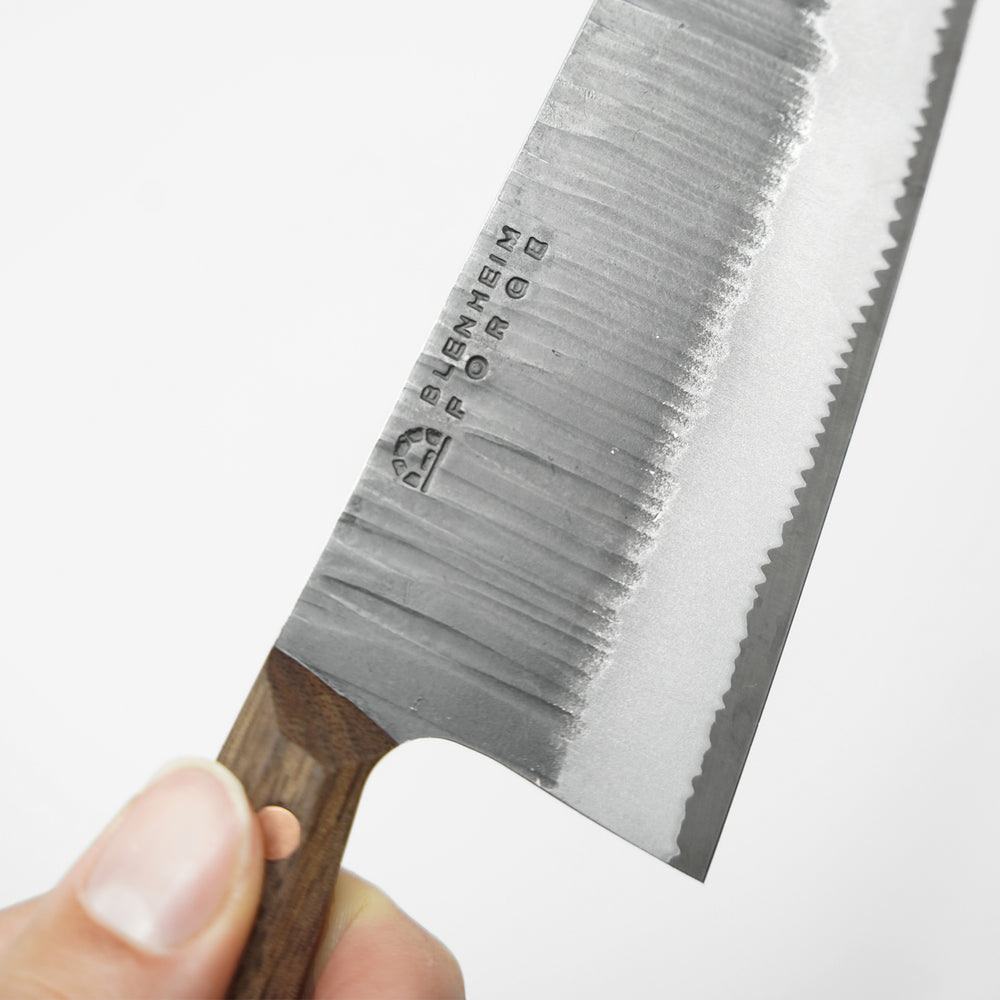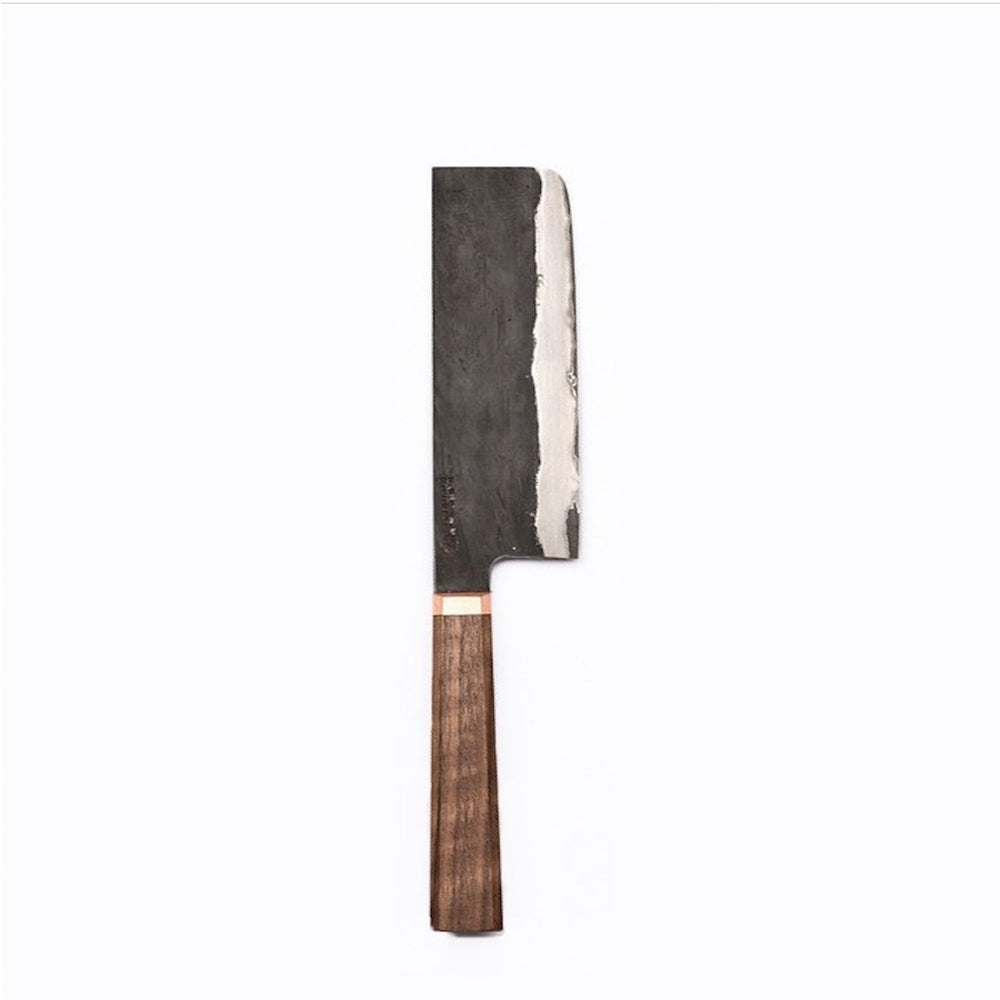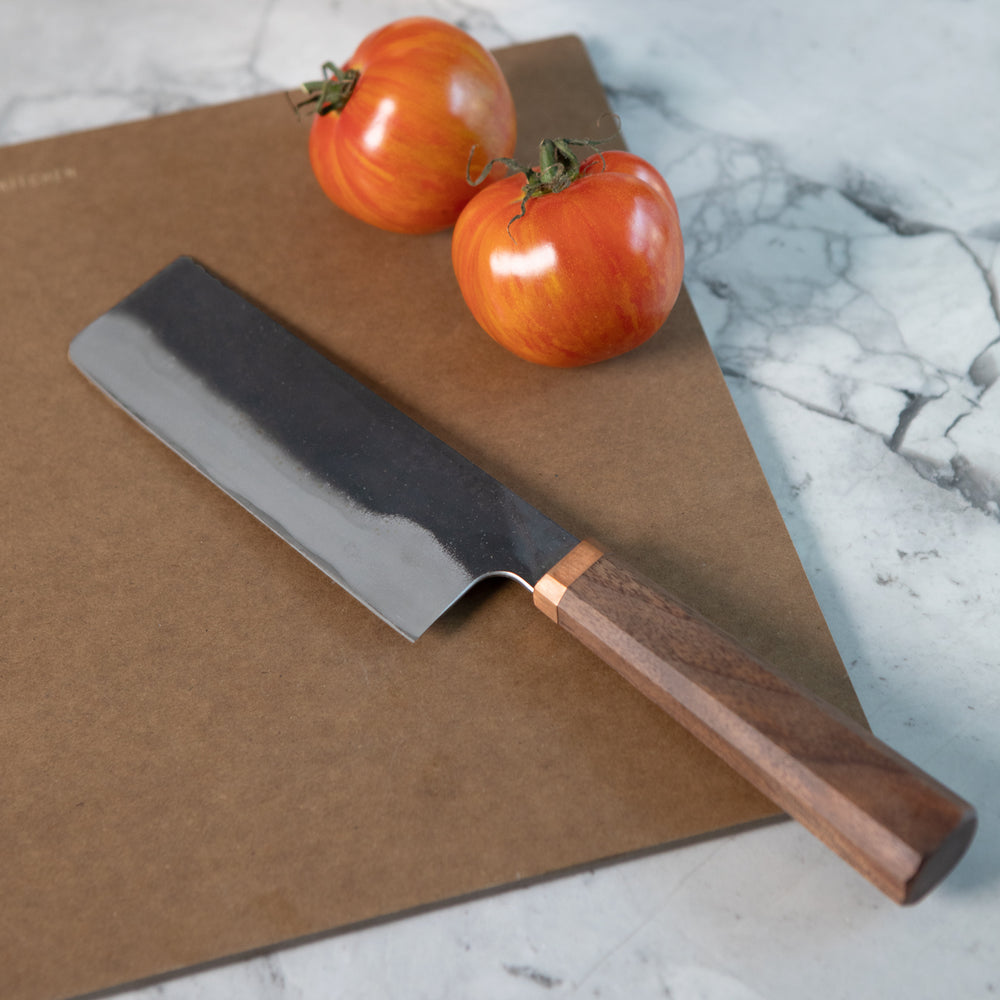Blenheim Forge founders James Ross-Harris and Jon Warshawsky created their first Japanese knife in the back garden they shared as housemates, in a forge made of fire bricks and a leaf blower. The forge they work in now, located under a railway arch in South London, is far more sophisticated – and so are their Japanese knives, praised by names like Nigella Lawson, Gordon Ramsay, and Argentine barbecue master Francis Mallman.
But that original quality – of friends creating a product entirely from scratch, out of a passion for working with iron and fire – is still there. (Even their machinery was developed in-house, by third co-founder Richard Warner.) The fact they’ve found their own, unique way to master the ancient art of Japanese knife-making is what makes them so remarkable.
The entrance to Blenheim Forge’s workshop in Peckham, South London.
Though their knives are undoubtedly beautiful, Blenheim Forge’s founders do not consider themselves artists or designers. They are blacksmiths, creating tools defined by function rather than aesthetic. Which is exactly what drew us to their knives.
Made from carbon steel, Blenheim Forge blades aren’t just super-sharp – they stay sharp for long stretches of time, and are easy to get back to mint condition with a quick sharpening session at home. The Blenheim Forge range we carry features carbon steel blades clad with stainless steel up to the blade’s edge for easier maintenance, as well as wooden handles made from trees sourced within the M25.

Left: Inside the workshop. Right: Co-founder James sharpening a knife.
On a recent visit to their Peckham workshop, we learned that it isn’t just these high-quality carbon steel blades that make Blenheim Forge knives unique. It’s also the way their blades are shaped, and Blenheim Forge’s process of individually grinding and sharpening knives by hand.
Below, we broke down the details of what makes a Blenheim Forge knife so exceptional into three components: the metal, the shape, and the handle.
The Metal
First things first: what is the difference between carbon steel and stainless steel knives?
Carbon steel is a harder metal than stainless steel, which gives it that superior edge retention that professional chefs rely on to see them through frequent daily use. Co-founder Jon told us that another major benefit of carbon steel is that it is easy to sharpen – even using a home sharpener like a whetstone or HORL, you can get a knife back to a condition that’s almost as good as it was out of the box. While stainless steel can still be sharpened at home to excellent results, it would need professional sharpening to get it to the same out-of-the-box level of sharpness.

The evolution of a Blenheim Forge blade. Notice the colour of the cutting edge on the final blade; that’s the carbon steel core.
The downside? Carbon steel, unlike stainless steel, is more fragile and prone to rust. To side-step this issue, our range of Blenheim Forge knives is made of laminated steel (also known as ‘san mai’ in Japanese). In other words, our Blenheim Forge carbon steel knives are clad with stainless steel except for the blade’s edge. This smaller area of carbon steel has two key benefits:
-
Less maintenance: All you need to do to keep one of our Blenheim Forge knives shipshape is to dry the blade thoroughly after washing, and wipe the edge with food-safe oil (olive, vegetable, avocado, etc) every now and then.
-
More durable: The softer, less brittle stainless steel cladding acts as a blanket to protect the harder and more fragile carbon steel core that forms the blade’s edge.
With san mai cladding, you can reap the rewards of a carbon steel knife, like superior sharpness and edge retention, without the extra maintenance and care.

Close-ups of grinding process and san-mai cladding.
Our Blenheim Forge knives use a core of premium Japanese blue paper steel, also known as Aogami super blue steel. Made from a combination of white paper steel derived from iron-rich river sand plus tungsten and chromium, it is considered in Japan and around the world to be the very best material for culinary knives. It’s easy to see why: The sharpness results in ultra-smooth cutting that you can hear as well as see, and it will hold its edge longer than other carbon steel knives. Until recently, Japanese blue paper steel was the only kind of steel made exclusively for culinary knives.
The Shape
If you place the back of a standard Japanese knife and the back of a Blenheim Forge knife side-by-side (see image below), you will notice a key difference. While the back of the standard Japanese knife has the same width from bottom to top, the back of a Blenheim Forge knife tapers from the base to the tip.

Left: Side-by-side comparison of the back of a standard Japanese knife and a Blenheim Forge knife. Right: Final Blenheim Forge santoku; notice the rounded bolster.
This is important for two reasons:
- The thickest part of the Blenheim Forge blade – on the back, just above the handle – is exactly where cooks need to ‘pinch grip’ a knife when chopping. This is a classic knife skills technique where the thumb and forefinger pinch the back of the blade, just above the handle, while the middle finger is tucked under the bolster (where the blade curves into the handle). This, along with the rounded bolster on Blenheim Forge knives, provides more power, control, and balance over the blade when chopping. (Since Japanese blades tend to be lighter in weight, this extra leverage is useful.)
-
It is very difficult to achieve this tapered shape on a mass scale. Since Aogami super blue steel is very fine, it can break easily if not handled with care. That’s why Blenheim Forge grinds every blade individually by hand, before sharpening the edge on progressively finer Japanese whetstones and a leather strop to finish.
The Handle
The octagonal handles on our Blenheim Forge knives, which are securely attached to the blades with a copper ferrule, are made from richly grained walnut wood, sourced from already-fallen trees within London’s M25. The wood is provided to Blenheim Forge by Goldfinch, a charity that specialises in teaching young people aged 16-25 how to make furniture and find employment in the field of woodworking.
The reason for the octagonal shape is that it allows for a more secure grip when chopping ingredients. But there’s another, more subtle benefit, which is that the handle helps guide you to finding the correct sharpening angle when using a whetstone. (Blenheim Forge knives must be sharpened at 15°.) Simply lay the handle on top of a whetstone and press the blade down; the corner of the octagonal handle will fall perfectly flat against the whetstone, forming a 15° angle.

Left: A drawing of the Blenheim Forge knife cutting edge, angled at 15° each side. Right: Close-up of English walnut wood handles.
Care & Maintenance
Blenheim Forge knives are Japanese-style knives, which means they require a bit more care and maintenance than Western-style knives. They should not be used to cut frozen or very hard foods, for example, and you should be careful when using it to cut meat, as sudden impact with bones could cause these blades to chip. (For our full guide on Japanese knife care, including storage, click
here.)
To take care of carbon steel knives, make sure to wash and dry the blades thoroughly after use. Every couple of weeks, use a tea towel to rub a bit of food-safe oil along the blade’s edge – vegetable oil or olive oil work fine here.







